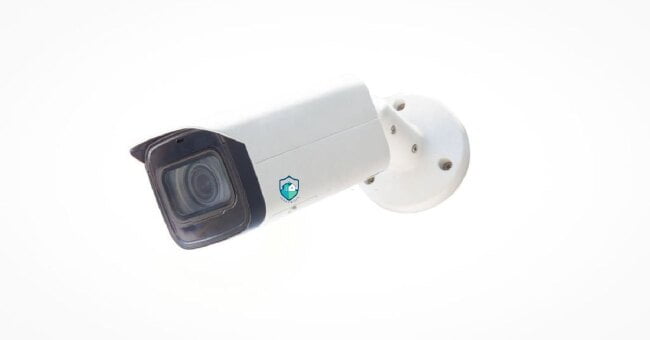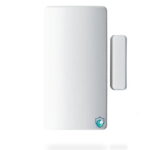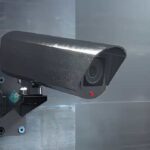Table of Contents
Do security cameras use a lot of electricity? This is a common question for homeowners and business owners looking to install surveillance systems.
After my husband and I were robbed last year, we decided security cameras were a necessity for our family’s peace of mind.
However, with two kids and an already tight budget, we worried about the impact on our electricity bills.
After thoroughly researching various camera models and power consumption estimates, we found affordable options that provide security without skyrocketing our energy costs.
I’ll share what we learned so you can make informed choices to protect your home in a cost-effective way.
In this post, we’ll take an in-depth look at how much power security cameras require. We’ll go over the factors that impact electricity use.
We’ll also provide tips to reduce security camera energy consumption.
Let’s dive in!
What Impacts Security Camera Electricity Use?
Several variables determine how much electricity your security cameras will utilize in your home or business. Here are some of the main factors at play:
Camera Resolution and Video Quality Needs
One of the biggest factors is the resolution of the security camera footage and the overall video quality.
- High definition and 4K security cameras will use more power than standard definition models.
- Footage that streams and records continuously will use more electricity than motion-activated recording.
- Night vision and infrared features will also increase energy consumption.
So before choosing cameras, think about your needs. If you just want to monitor points of entry, lower resolution and motion-based recording may suffice.
But if you want to capture faces and identify people on a large property in all conditions, higher resolution 4K cameras with night vision will use more power.
Wired vs Wireless Camera Setup
How your cameras connect to your network also impacts electricity use:
- Wireless security cameras may seem simpler, but they use more power since they have to transmit footage over WiFi constantly.
- Hardwired PoE (power over ethernet) cameras connect directly to your router and draw less power for data transmission.
So from an energy savings standpoint, choose wired over wireless cameras whenever feasible.
Location and Environmental Conditions
Your climate and placement of cameras can also affect electricity consumption:
- Outdoor cameras in hot climates may use more energy for cooling systems to prevent overheating.
- Similarly, cameras in very cold climates may consume more power if they have built-in heaters.
- Cameras exposed to lots of sun may rely more on solar power systems.
- Indoor cameras in temperature controlled environments will typically use less energy.
So optimizing camera placement can help minimize environmental factors that increase electricity usage.
Now that we’ve covered the key factors impacting security camera power consumption, let’s go over ways to estimate your actual usage.
Do security cameras use a lot of electricity? Let’s Calculate
Determining roughly how much power your specific security camera system will require takes a bit of math. Here are some tips to estimate your usage:
Using Wattage Ratings to Estimate Usage
Looking at the wattage rating of your cameras helps provide a baseline for calculations:
- Most PoE IP cameras consume between 4 to 12 watts.
- Pan-tilt-zoom (PTZ) cameras range from 20 to 30 watts due to motion.
- Older analog CCTV cameras can use 10 to 60 watts.
From the wattage rating, you can calculate the daily kilowatt-hour (kWh) usage by multiplying by the number of hours of operation per day.
- For example, a 10 watt camera running 24/7 would use 10 x 24 = 240 watt hours or 0.24 kWh per day.
- At the average cost per kWh of $.12, that’s about $.029 per day for that one camera.
Add up the usage of all your cameras to estimate the total impact. Remember, these are just rough estimates – actual usage may vary.
Using Manufacturer Specifications
For more precise estimates, look at the manufacturer specs for power consumption on your specific camera models.
Most brands provide technical specifications showing:
- Idle power draw (when not active)
- Max power draw (when recording)
- Estimated usage per day or month
This data provides better estimates than the generic wattage approach. Always look for this info before purchasing cameras so you know projected usage.
Considering Additional Equipment
Don’t forget the power needs of additional security equipment like:
- DVR recording boxes
- Monitors and displays
- Network equipment like switches and routers
- Backup batteries
- Heaters, cooling systems, or solar panels
Factor these items into your total estimated electrical load. Anything plugged in and supporting your cameras will add to energy usage.
Now let’s go over some ways to minimize the power consumption of your security camera system.
Tips to Reduce Security Camera Energy Consumption
While security cameras do require electricity, you’re not at the mercy of high energy bills. There are many ways to reduce and optimize consumption:
Selecting Energy Efficient Models
When selecting cameras, look for energy efficient models specifically designed to conserve power:
- Choose PoE wired cameras to reduce wireless data transmission needs.
- Look for cameras with motion activation to limit recording time.
- Select lower resolution cameras if high definition footage isn’t essential.
- Consider solar powered outdoor camera models to reduce dependence on electricity.
Choosing the right equipment is a key factor for lowering electricity usage.
Optimizing Camera Settings
The settings and features you enable on the camera system also impact energy efficiency:
- Only record video when motion is detected to avoid constant power draw.
- Set cameras to turn off infrared/night vision when not needed.
- Reduce unnecessary features like pan/tilt/zoom if not required.
- Use optimal compression standards like H.264 to minimize data loads.
- Adjust resolution and frame rates to the minimum acceptable level.
Optimized settings ensure you don’t waste power on non-essential capabilities.
Using Solar Powered Options
For outdoor cameras, solar power panels can offset daytime electricity usage:
- Solar panels recharge batteries that provide power through the night.
- During the day, the sun powers the camera directly reducing grid dependence.
- Solar setups make the most sense for rural, off-grid installations.
Solar won’t completely eliminate dependence on electricity. But it can greatly reduce power consumption from the grid.
Hardwiring When Possible
As mentioned earlier, wired PoE cameras are far more efficient than wireless models:
- Hardwired cameras don’t waste power transmitting data over WiFi signals.
- The ethernet cable provides all the power and data transmission needs.
- Wireless cameras can use 4x to 10x more power compared to wired models.
So if you can physically install ethernet cabling, choose wired PoE security cameras whenever possible for maximum efficiency.
By selecting the right equipment, optimizing settings, utilizing solar, and hardwiring, you can minimize the electricity usage of your security camera system.
But what does this actually mean for your utility bill? Let’s talk costs.
Security Camera Costs – Are They Worth It?
Okay, we’ve covered a lot of technical factors on estimating and reducing security camera electricity usage. Now, what does this mean for your actual utility bill and budget?
Average Electricity Cost Per Month
Generally, most homeowners can expect the following when adding a security camera system:
- A small system with 2 to 4 cameras will add about $5 to $10 per month to your electricity bill.
- A larger system with 10 cameras could add around $40 to $60 per month depending on usage.
- Systems drawing continuous high wattage may cost $100 or more monthly.
But that’s for a typical setup not using any of our energy saving tips above. If you optimize your system, you can likely cut those costs in half or more.
Weighing Expenses Against Benefits
When looking at the expenses of owning security cameras, you also have to weigh the benefits:
- What value do you place on securing your home, family and property?
- How does improved security and prevention of crime factor into the return on investment?
- Do insurance discounts for monitored systems make up for the added electricity costs?
Depending on your needs and priorities, the peace of mind and security provided by cameras may be worth the power usage they require.
Ways to Offset Added Electricity Usage
If energy efficiency is still a priority for you, there are creative ways to offset the added electricity usage:
- Use solar panels to generate power during the day that feeds your home and cameras.
- Look into energy tax rebates and credits if installing very efficient models.
- Invest in new insulation, windows, and other efficiency upgrades to balance increased costs.
- Consider enrolling in utility bill offset programs to make your energy use carbon-neutral.
With smart planning, you can still reap the benefits of home security while minimizing impacts to your monthly utility bills.
What Is The Difference Between Rechargeable And Non-Rechargeable Batteries For Security Cameras?
Rechargeable and non-rechargeable batteries have some differences when it comes to powering security cameras.
Here are some of the differences based on the search results:
Rechargeable batteries:
- Can be charged many times over after the initial purchase, making them more cost-effective in the long run.
- Have a higher energy density than non-rechargeable batteries, allowing them to store more energy and provide longer battery life.
- Have a longer lifespan than non-rechargeable batteries, making them a more reliable and cost-effective option.
- Are environmentally friendly since they can be reused several hundred times, reducing waste.
- Can be quickly recharged, making them ideal for cameras that need to be used frequently.
Non-rechargeable batteries:
- Are initially less expensive than rechargeable batteries.
- Last longer than rechargeable batteries, but only initially.
- Are designed to provide consistent power output for extended periods of time, making them suitable for devices that require consistent power output, such as security cameras.
- Are more reliable than rechargeable batteries and can provide a consistent level of power over an extended period of time.
- Are better suited for low-power devices that draw low amounts of power, such as some wall clocks, headlamps, or bike lights.
Frequently Asked Questions About Security Camera Electricity Usage
Got more questions about how much power your security cameras will use? I’ll try to answer some of the most common FAQs here.
How many watts do outdoor security cameras use?
This depends on the type of outdoor camera:
- Basic wireless outdoor cameras use about 4-7 watts of power during operation.
- More advanced wireless cameras with night vision and streaming can use 15-30 watts.
- Wired PoE outdoor cameras average about 12-20 watts of consistent power consumption.
Outdoor cameras tend to use more electricity than indoor models since they have to withstand the elements. Additional features like IR night vision, wireless transmission, and motion-activated floodlights will also increase the wattage.
Do PoE cameras use electricity?
Yes, PoE or Power over Ethernet cameras do require electricity to operate. However, they are generally more energy efficient than wireless cameras.
This is because PoE cameras get both data and power transmitted over a single ethernet cable. They don’t have to use additional electricity for wireless video transmission like WiFi cameras.
So while PoE cameras do use power, they utilize less of it compared to wireless models. A single PoE camera will typically consume between just 4-12 watts.
How much will a DVR system add to my electricity costs?
Most DVR recorder boxes used for multi-camera systems consume about 15-35 watts of electricity consistently.
To calculate how much this adds in terms of costs:
- Find the wattage rating of your DVR box.
- Multiply the wattage by 24 hours to get the daily energy use in watt-hours.
- Divide the watt-hours by 1000 to convert to kilowatt-hours (kWh).
- Multiply the daily kWh by 30 to estimate the monthly usage.
- Multiply the monthly kWh by your electricity rate per kWh for the estimated monthly cost.
For example, a 30 watt DVR running 24×7 would use about 30 x 24 = 720 watt-hours per day. That’s 0.72 kWh per day. Over 30 days that’s 21.6 kWh.
At an electricity rate of $0.12 per kWh, that’s $2.59 per month for the DVR power consumption.
Should I turn off security cameras when not in use?
It’s generally recommended to leave security cameras on at all times for maximum monitoring capability and preparedness.
However, you can optimize your system to use less continuous power:
- Set cameras to disable night vision infrared during daytime hours.
- Use motion sensors so cameras record only when needed.
- Reduce unnecessary camera movements and scanning in PTZ models.
- Adjust the resolution and frame rate to the minimum usable settings.
You can also consider plugging cameras into smart switches to cycle power on and off during certain periods. Just be aware this reduces your monitoring coverage when powered down.
How can I power a remote outdoor camera not near an outlet?
For outdoor cameras located far from an electrical outlet, you have a few options:
- Use a PoE extender kit to send power over a longer ethernet cable from your network switch.
- Install solar panels sized to handle the camera power consumption.
- Use an outdoor-rated power over ethernet injector that plugs into an interior outlet and sends power to the camera via ethernet cable.
- Use a wireless bridge kit to transmit data and power wirelessly from an interior outlet to the remote camera.
With the right extension, solar and wireless options, you can install security cameras in hard-to-reach exterior locations lacking traditional electrical outlets.
Can smart home devices like Alexa integrate with and control security cameras?
Many home security cameras now offer integration with smart home platforms like Amazon Alexa. This allows you to view camera feeds and control certain functions using voice commands.
For example, you could say “Alexa, show me the front door camera” and it will display the live stream on a compatible smart display. Or you can tell Alexa to record a clip from a certain camera on demand.
The degree of functionality varies by camera model and manufacturer. But in general, you can use supported voice assistants to monitor and access your security cameras around the home. Just make sure to verify compatibility before purchasing a camera system.
Conclusion
Phew, we covered a lot here today! Let’s do a quick recap:
- Security cameras can consume a fair amount of electricity, especially high resolution models.
- Wired PoE cameras are generally more efficient than wireless models.
- You can estimate usage based on wattage ratings or manufacturer specs.
- Features like night vision and higher camera counts increase power needs.
- Settings like motion activation and solar power help save energy.
- For most homes, costs are reasonable at $10 to $60 monthly.
- The security benefits may outweigh the power costs depending on your needs.
- With solar, offsets and efficiency upgrades, you can minimize the electricity expense.
I hope this overview gives you a better understanding of security camera power consumption. The key takeaway – with some planning and optimization, you can enjoy enhanced home security while still being energy responsible!
What questions do you still have about security camera electricity usage? Ask away in the comments! I’m happy to provide any additional details.




